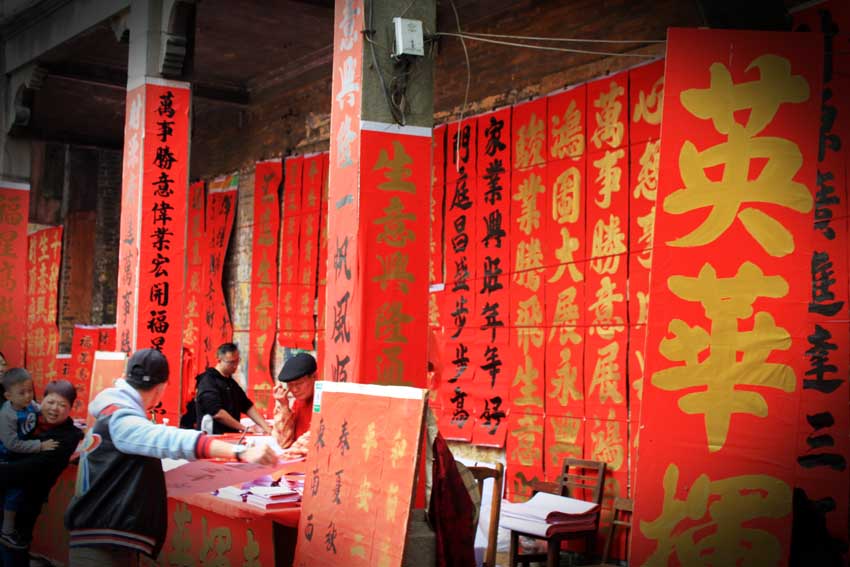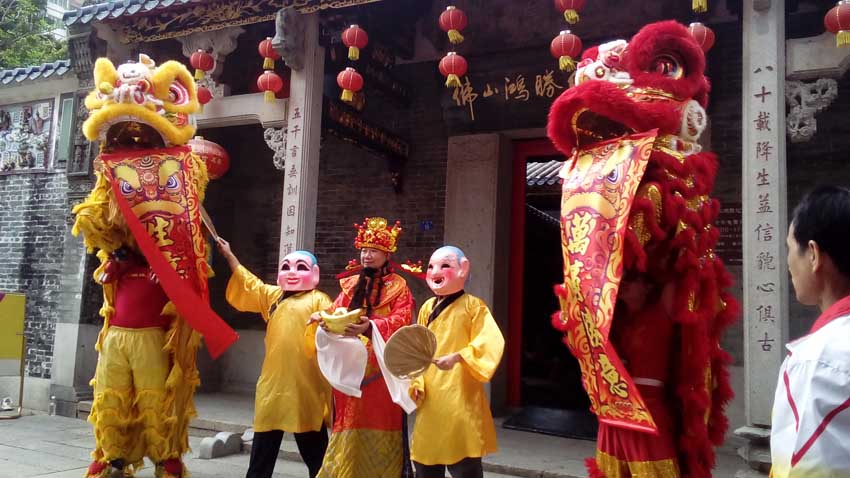The Spring Festival (Chūn Jié 春节) marks the beginning of the new year according to the Chinese calendar*, on the second new moon after the winter solstice. According to popular belief, in the beginning of time there was a mythical beast called Nián 年**, which during the winter, to alleviate the lack of food, roamed the villages devouring human beings, especially children. One day, someone observed that the beast was frightened by the red colour and bright lights, and decided to confront him by placing red papers and throwing firecrackers, getting the monster away frightened. This was the beginning of the spring Festival.
For the Chinese, it's a period of family reunion. Cities are emptied and everyone travels to their hometowns, back home. This is the longest holiday of the year, extending for fifteen days.
The Chinese are very superstitious and do not take traditions lightly. Before the end of the year, all the corners of the house have to be cleaned thoroughly to scare away the bad luck that can remain of the previous year; debts must also be paid and disputes settled and the temples visited to pay homage to the ancestors. The doors of the houses are adorned with red papers and lanterns with Chinese characters to attract wealth and good fortune. Among these auspicious characters predominates the word Fú 福, whose meaning can be translated as fortune or happiness.


Stands where good fortune messages are written on red papers for New Year
Inside, the houses are filled with flowers and plants, like orchids and peonies, or branches of peach and cherry blossom, and especially orange and mandarine trees, which are placed at the house entrance and are considered as carriers of good fortune.
But the biggest celebration takes place on New Year's Eve. On that date all the family members are gathered for dinner and then welcome to the New Year. At the table, the food also has its meaning. Among the varieties of dishes that can be served, if there are some that cannot be missing on New Year's Eve, those are certainly fish and chicken. In Chinese, the word "fish", yú 鱼, and the word "abundance", yú 余, are homophones, so fish is a symbol representing wealth and prosperity. It has to be served whole, and as one eats from the top, must remove the bone and continue eating the bottom, but never turn the fish because it is considered bad omen. Chicken also represents wealth, and it is served whole to symbolize the union of the whole family.
There are other typical dishes of these dates with specific meanings, such as long uncut noodles, which represent longevity; glutinous rice cakes, nián gāo 年糕, whose name is pronounced the same as nián gāo 年高, "every year better"; green vegetables that promise good harvest, and a long etcetera.
After dinner, firecrackers and fireworks are thrown in the middle of the night to scare off Nián and evil spirits.
Martial arts schools are in charge of organising Lion Dances.
For New Year, the elders give young people the so-called hóng bāo 紅包, small red envelopes that contain money. Those hóng bāo do not usually contain a high ammount of money, but rather symbolic. A number with two digits repeated is considered ideal, such as 11, 22, etc. But it is very important to avoid the number 4, because in China is of very bad omen, because its pronunciation, sì 四, sounds almost equal to that of the word "death", sǐ 死. Specially auspicious numbers are 8, bā 八, which sounds similar to fā 發 , "prosperity", or, in Cantonese, 6, lok 六, homophonous of lok 樂, "happiness".
During the days following Chinese New Year, the streets are flooded with celebrations, highlighting Lion Dance. Usually, martial arts schools are in charge of organising these dances. In them, two dancers hold a frame that resembles the body of the lion, and perform acrobatic movements that mimic those of the animal, with music of drums and gongs. To execute the Lion Dance is necessary a great physical condition and great skill. Inside the lion, the person who goes in front holds and shakes its head, and manages the springs that move the eyes, ears and mouth of the lion. The person who goes behind grabs the person in front from the waist, and goes with the trunk completely folded forward and covered by a mantle: he is the body and the rear legs of the animal. This person must also possess a great physical strength and is usually more robust than the one ahead, as he will have to lift him or her in the air multiple times.

Lion Dance team of the Hung Sing Gun 鴻勝舘 in Fóshān 佛山, training for new year.
The rear dancer has to fully lift the one that goes in front holding the lion's head.
Lions carry good fortune, and they deliver it to those with whom they stumble on their journey through the streets of the city. It is common to see them entering restaurants, shops and other businesses to attract prosperity in the new year. Some establishments place lettuces hanging from the ceiling, accompanied by a hóng bāo, which is a donation to the school that organizes the dance, and the lion has to stand on two legs to catch the lettuce with the mouth. This is a maneuver that requires a hard workout, because the person who goes back inside the lion lifts completely in the air to the front person with the head, so that it can collect the lettuce through the lion's mouth. After swallowing the lettuce, the lion spits it, destroyed in a thousand pieces, and it is considered that the one who is touched by a piece of lettuce will be specially fortunate.
Notes:
* The Chinese calendar is governed by the phases of the moon, starting a new month with each new moon. Each year is usually twelve months, which produces a continuous gap in relation to the western solar calendar. That is why there are thirteen-month years that compensate this gap. This system began to be used in the year 2637 BC.
** Note that Nián 年 is also the Chinese word for year.
